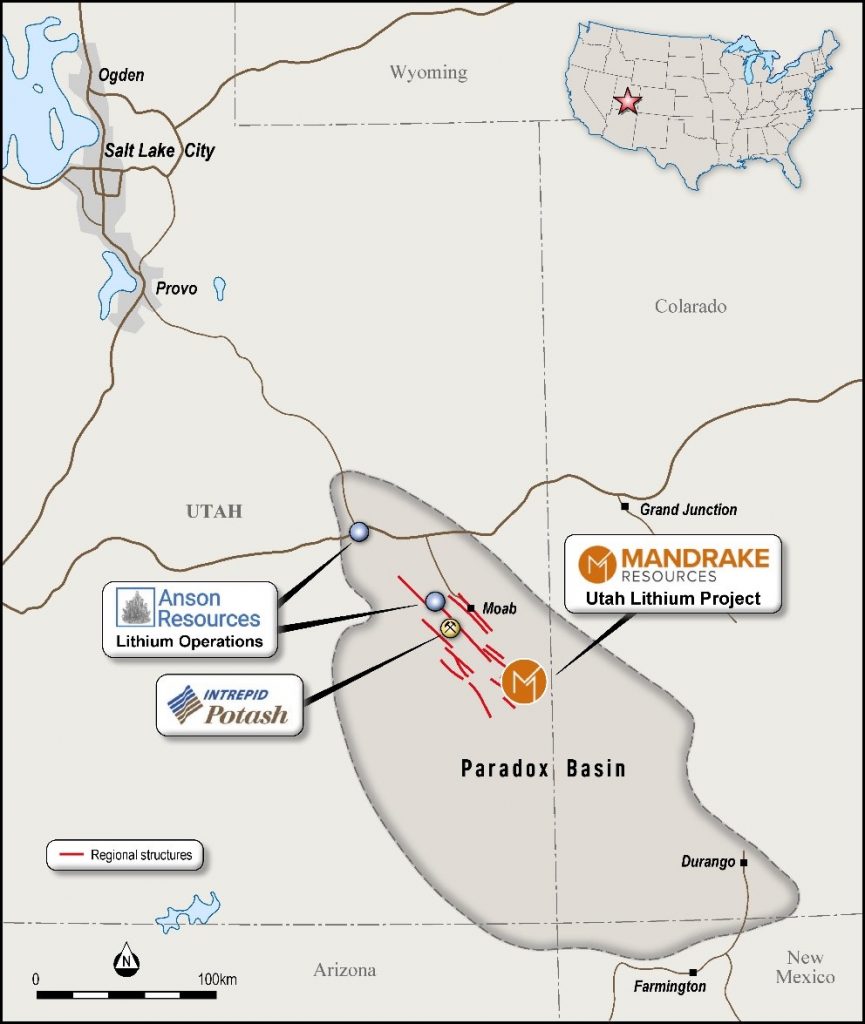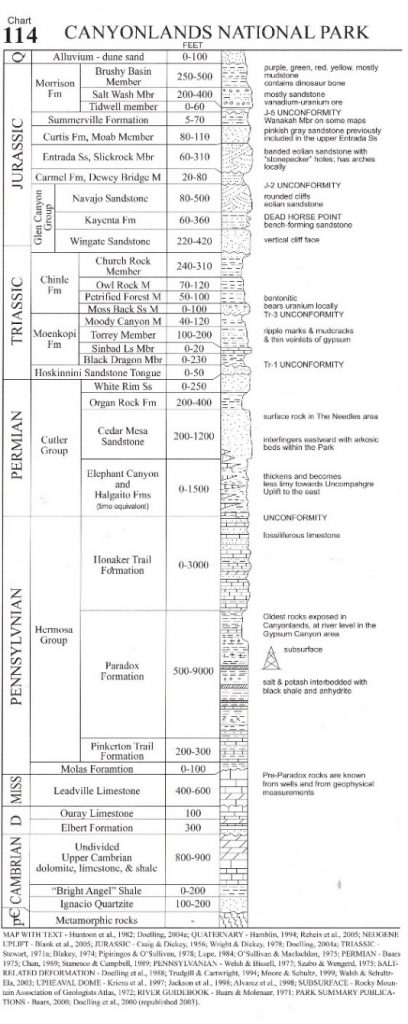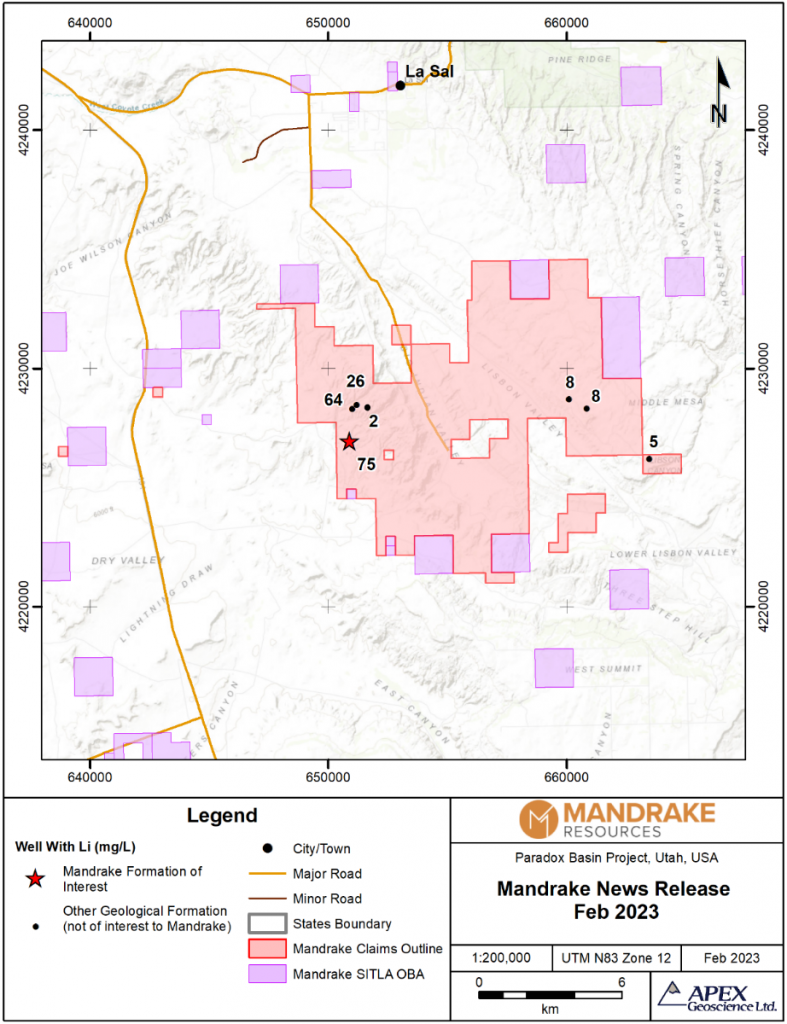Mandrake is developing a world-class large-scale lithium project in the Paradox Basin, USA where an Inferred Resource (JORC 2012) estimate of 3.3Mt Lithium Carbonate Equivalent (LCE) has been defined (see Mandrake’s announcement dated 22 October 2024).
The Paradox Basin in the south-eastern Utah ‘lithium four corners’ area hosts hypersaline brine historically documented to contain significant concentrations of lithium, boron, potassium salts (potash) and other elements. The United States’ biggest potash producer, Intrepid Potash (NYSE: IPI) operates the Cane Creek potash mine which is located approximately 50km to the north west of the Utah Lithium Project whilst mid-tier ASX-listed lithium developer Anson Resources (ASX: ASN) is located approximately 60km north west (Figure 1).
Figure 1: Location of the Utah Lithium Project

Project Geology and Lithium Brines
The Paradox Basin is composed of sedimentary rocks that overlie an Early Proterozoic basement of metamorphic gneiss and schist that is locally intruded by granite (Nuccio and Condon, 19961; Tweto, 19872). The prospective reservoir brine occurs in deep-seated, confined Paleozoic sedimentary reservoirs, or aquifers, that are still being assessed and may vary in depth between 2,000 and 7,000 feet (610 and 2,134 metres) below surface.
The geological units of most interest to Mandrake currently include the Pennsylvanian age Paradox Member (within the Hermosa Formation) and the Mississippian Leadville-Ouray Limestone Formation (Leadville Limestone; Figure 2).
Figure 2: Paradox Basin Precambrian to Permian Stratigraphy3

The Utah Lithium Project is in the northern Paradox Basin where numerous oil and gas companies operate wells which can be re-entered to collect brine for assaying and mineral processing test work. The brine is historically documented to be saturated with halite (salt), along with other minerals of interest including the potential for lithium, magnesium, boron, bromine, and potash.
Mandrake has conducted a compilation of historical brine analyses from oil and gas wells within the Utah Lithium Project (Table 1, Figure 3). Most of the historical lithium-brine analytical results are from geological units that are not of interest to Mandrake (i.e., Culter-Honaker Trail and McCracken formations). A lithium result of 75.0 mg/L Li is documented from brine collected from the Leadville Limestone Formation in the Lisbon B 815 well; this formation is a target geological unit of interest to Mandrake.
Table 1. Summary of historical lithium-brine analytical results (all stratigraphic horizons) at Mandrake’s Utah Lithium Project. The yellow highlighted records represent wells that have penetrated and sampled brine from Mandrake’s current stratigraphic units of interest.

Figure 3. Historical lithium-brine results at Mandrake’s Utah Lithium Project. The red star well(s) that have penetrated and sampled brine from Mandrake’s current stratigraphic units of interest.

USA – An Outstanding Location for a Lithium Player
The US has recently introduced extensive measures to secure strategic and critical materials, particularly lithium, from what the US government terms ‘non-adversarial’ sources, that is, sourcing these materials domestically from the US and close allies.
This stated US strategy has culminated in the Inflation Reduction Act 2022 (IRA) which is the largest piece of US federal legislation ever to address climate change. It will invest US$391 billion in provisions relating to energy security and climate change.
Within the IRA framework is the Department of Energy’s (DoE) American Battery Materials Initiative, a new effort to mobilize the entire US government in securing a reliable and sustainable supply of critical minerals used for power, electricity, and electric vehicles (EVs). President Biden has set an ambitious goal to make half of all new vehicles sold in 2030 electric.
Australian company Ioneer (ASX: INR) recently secured a US$700 million (AUD$1 billion) loan from the US DoE to develop its lithium-boron project at Rhyolite Ridge in Nevada4 whilst Piedmont Lithium (ASX: PLL) secured a grant of US$141.7M from the DoE to assist building its lithium plant in Tennessee5.
The US Department of Defense has also released a significant funding and grants package for critical materials under the Defense Production Act (DPA), with the DOD stating, ‘U.S. adversaries have a demonstrated pattern of using their economic power in critical materials markets to harm the U.S. / allied industrial base, and the possible exertion of that strength against the defense industrial base and domestic critical infrastructure poses a risk to the United States’.
As such, sustainable and responsible domestic mining, beneficiation, and valued-added processing of strategic and critical materials used in the production of large capacity batteries is critical to national defense and the preservation of domestic critical infrastructure”.
US industry is also participating heavily in the quest to sharply increase US domestic sources of critical materials, illustrated by the investment by General Motors (GM) of US$650M in equity into Lithium America’s Thacker Pass Lithium Project in Nevada6.
Utah Lithium Forward Work Programme
Having compiled detailed datasets relating to historic well logs, petrophysics, stratigraphy and local geology, Mandrake is well placed to rapidly advance the Utah Lithium Project. Going forward, Mandrake will undertake the following:
- Conduct exploration work toward the upgrade of the Mineral Resource from Inferred to Indicated in accordance with JORC 2012.
- Sampling of existing wells (and potential drilling of new well(s)) to obtain brine to verify historical lithium-brine geochemical results and conduct initial mineral processing test work to validate the potential extraction of lithium from Paradox Basin brine.
- The brine sampling program will enable Mandrake to formulate opinions on which reservoirs and/or areas have the greatest lithium-brine potential.
- Continue the investigation of suitable Direct Lithium Extraction (DLE) technologies with potential development partners.
- Assessment of grant/loan/support options available through US government and industry groups/programmes.
References
1 Nuccio, V.F., and Condon, S.M., 1996, Burial and Thermal History of the Paradox Basin, Utah and Colorado, and Petroleum Potential of the Middle Pennsylvanian Paradox Formation: U.S. Geological Survey Bulletin 2000-O
2 Tweto, Ogden, 1987, Rock units of the Precambrian basement in Colorado: U.S. Geological Survey Prof. Paper 1321-A
3 Hintze, L.F & Kowallis, B.J 1988, Geologic History of Utah: Department of Geology, Brigham Young University
4 INR ASX release dated 16 January 2023
5 PLL ASX release dated 20 October 2022
6 LAC NYSE release dated 31 January 2023

